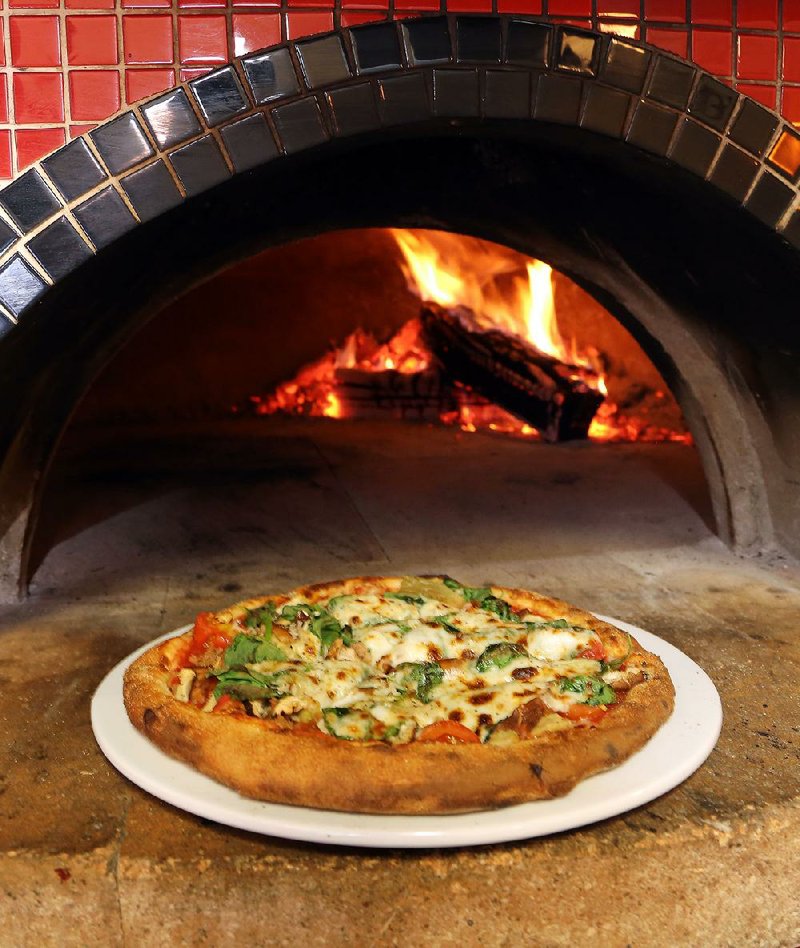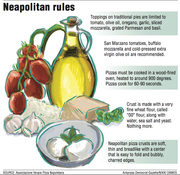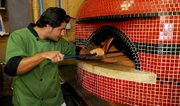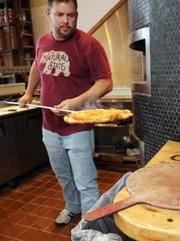Chicago may have its deep dish, and New York its oversize slices, but a far more traditional pie is taking hold in Arkansas restaurants.
Across the state, Neapolitan pies have become the new go-to for locally owned pizzerias, popping up in Little Rock, Fayetteville and beyond. The wood-fired pizzas are known for simple, fresh toppings and a thin, soft-centered crust with charred edges. One classic style, the Margherita pizza, dates to the 1880s, but Italians had been noshing on tomato-topped flatbreads for decades.
To be a true Neapolitan pizza (aka "Napoli-style" pizza or "pizza napoletana" if you prefer saying things with an accent), there are certain rules that chefs must follow.
The Associazione Verace Pizza Napoletana, an Italian group, began in 1984 in order to establish protocol on what could be called "Neapolitan." The organization outlines rules for nearly every step in the pizza-making process, from the sauce to the tool used to remove a cooked
pie from the oven.
Since a Neapolitan pizza is often recognized by its crust, the association spares no detail in describing how those pizza bases should be created. The dough must contain just four ingredients: water, yeast, salt and flour. But not just any water, yeast, salt or flour is accepted.
According to the association, a Neapolitan crust is made with a finely milled wheat flour -- known as type "00" flour -- along with sea salt and water that's around 70 degrees with a pH of 6 to 7. The dough should be mixed for about 10 minutes, kneaded for 20 minutes, allowed to rise for two hours and then placed in "rising boxes" for another four to six hours before being topped and popped into a wood-fire-oven heated to about 900 degrees for 60-90 seconds. The association dictates that ingredients, above all, be high quality, including San Marzano tomatoes, buffalo mozzarella, cold-pressed olive oil, fresh basil and Parmesan.
"It's the simple ingredients that create something very magical," says Scott McGehee, executive chef for Yellow Rocket Concepts in Little Rock. "Because it's higher-quality ingredients, you need fewer of them. You don't need sugar in your tomato sauce or processed cheese with a lot of fat."
At McGehee's ZaZa Fine Salad & Wood Oven Pizza Co. in Little Rock and Conway, pizzas come to the table looking far from the classic, delivery-style American pies many have grown up knowing. The pies are topped gingerly, with plenty of tomato sauce showing through. The crust is thin and pliable on the bottom (thanks to the short cooking time), but thick, bubbly edges carry plenty of char.
"In the beginning, we got a lot of flak about the crust," McGehee says of the response when ZaZa first opened in 2008. "People thought it was burnt. We had to tone it down a bit ... but now, I think people expect it."
Along with ZaZa, Little Rock restaurants such as Izzy's and Local Luna were early adopters in adding wood-fired pizzas to their dinner menus. Loca Luna owner Mark Abernathy says he put wood-fired pizzas on the menu when the restaurant first opened in 1996.
But it wasn't until the last few years that Neapolitan-style pizzas have gained popularity in Arkansas. Now, options for takes on the style include Bruno's Little Italy, The Pizzeria at Terry's Finer Foods and Raduno Brick Oven and Barroom in Little Rock; Ristorante Capeo in North Little Rock; DeLuca's Pizzeria in Hot Springs; Wood Stone in Fayetteville; and MJ Pizzeria in Springdale -- each starting its pizza business in just the past two years.
The reason behind the boom may be as simple as supply and demand. According to a 2014 survey by the Centers for Disease Control and Prevention, on any given day 13 percent of the U.S. population over age 2 will eat pizza. For males ages 6-19, proportion rises to 25 percent.
For restaurants, opting for Neapolitan style means the pies can go from the oven to the pizza-hungry American masses much faster than in traditional ovens -- a mere 60-90 seconds compared to the 15-20 minutes that some thicker pies need to bake. That makes the style especially suited for lunch crowds or fast-casual restaurants. Chef Eric Isaac of Ristorante Capeo added Neapolitan-style pies to the restaurant's Italian menu earlier this year, using the addition to launch the restaurant's new lunch service.
And then there's the flexibility of playing with toppings. Like crusty sandwich bread or a well-made tortilla shell, a pizza crust can be a vehicle for boundless combinations.
"A Napoli-style pizza is a blank canvas in this incredibly fun way," says McGehee, who can often be found experimenting with in-season produce such as peaches, figs or butternut squash as toppings for pies.
Not that the Associazione Verace Pizza Napoletana would necessarily approve of figs and peaches. But a seal of approval from the association isn't a top priority for many of the Neapolitan-style pizzerias in Arkansas. Instead, the emphasis here is on style, with each chef tweaking the formula to create a pizza that's right for his restaurant and the customers they serve. While The Pizzeria at Terry's Finer Foods, Bruno's Little Italy and Ristorante Capeo all serve a pizza crust that is very soft in the middle -- think a step beyond the fold-to-eat New-York style -- other chefs, including the folks at Raduno and DeLuca's, prefer a slightly sturdier center to the crust.
"We keep to the tradition of how all the old pizzas were made, making everything by hand, but the reality is that the traditional crust was just too soggy for people ... it was too soggy for me," Anthony Valinoti, owner and chef at DeLuca's, says. "What I wanted to do is find something that's a little more crisp and has more structure when people order more than just the cheese and tomato and basil."
Valinoti swapped out the traditional type "00" flour in favor of a bread flour that provided a little more chew. The result is a hybrid of Neapolitan and New York-style that suits the Brooklyn native. Open four days a week, Valinoti makes only enough dough for about 85 pies a day. The demand is so high, he encourages his customers to call ahead and reserve their dough.
"We're selling out every night, and that's a beautiful thing," Valinoti says.
Style on 09/08/2015




